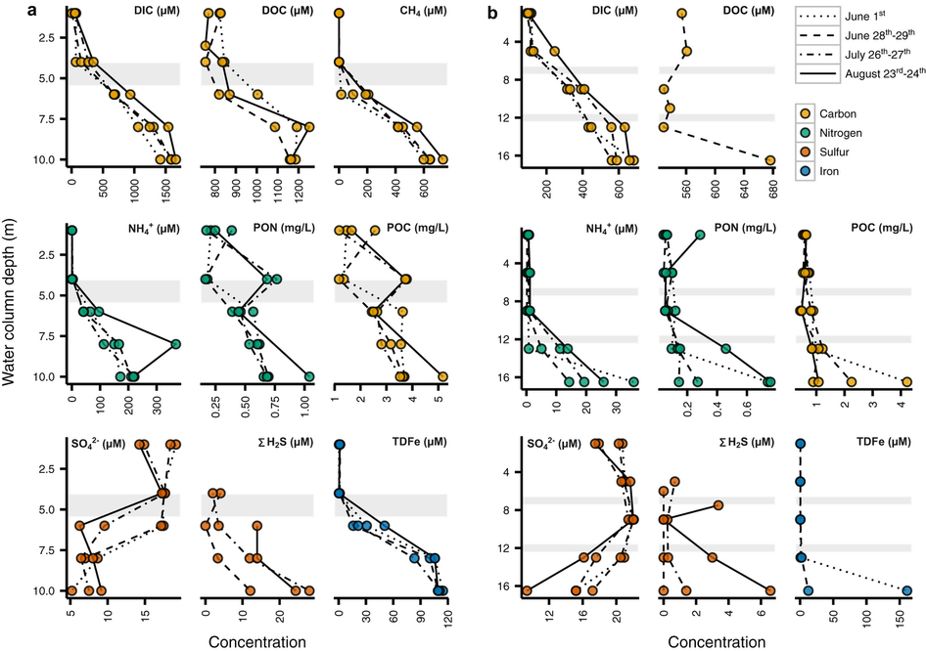One way to investigate the mysteries of Earth’s origins is to look for modern-day equivalents of ancient oceans and examine their chemical processes and biological diversity. However, the challenge is that modern equivalents of ancient oceans are extremely rare. Only four previously identified lakes shared similarities with the Archaean eon oceans of more than 2.5 billion years ago.
Early microbial life originated in oxygen-free oceans of the Archaeon that were low in sulfur and high in iron. We hypothesized that bottom layers of stratified lakes in the Boreal Shield region in northern Ontario, Canada – that are also low in sulphur and high in iron during anoxic conditions found periodically during the summer and under ice in winter – could potentially serve as modern field laboratories for advancing the scientific understanding of microbial metabolic pathways, such as photosynthesis,in both the Archaean Ocean and in modern lake environments.
Methodology
Boreal Shield lakes have been studied intensively at the Institute for Sustainable Development Experimental Lakes Area (IISD-ELA) in northwestern Ontario, Canada. The study was conducted on two lakes – Lake 227 and Lake 442 – that are exceptionally well characterized and include comprehensive data of nearly fifty years. Our team of earth scientists and microbiologists collected additional water and sediment samples from 2010 as part of the world’s longest running nutrient addition experiment to examine eutrophication science. We combined novel isotopic and nucleic acid sequencing approaches to examine processes in the anoxic zone of these lakes.
Outcomes
This study provided the first evidence for photoferrotrophy in Boreal Shield lakes, which is thought to represent one of the earliest forms of photosynthesis to evolve on early Earth, where light-driven iron oxidation is coupled to carbon fixation (i.e. primary production). Further, the study shows how distinct isotopic and chemical indicators can be used to search for the corresponding bacteria that catalyze this reaction. This discovery was a surprise, arising from the pursuit of unexpected results and combining new advances in microbial molecular techniques and isotopic analysis of iron.
More specifically, the study showed that anoxic zones in the lower layer of the lakes had low sulfate (ranging from 5 to 21 μM) and high total dissolved iron (TDFe; reaching a maximum of 115 to 162 μM) over the summer sampling season (Fig. 1). These results were comparable to the values found in the few other lakes worldwide that have been identified with the potential for photoferrotrophy.

Figure 1: Water chemistry of (a) L227 and (b) L442 water columns. All samples were collected in June-August 2010. Measurements from the same sampling dates are connected by lines for visual clarity. Sampling dates include those from before the onset of the annual cyanobacterial bloom (June 1st), during the bloom (June 28th–29th), and after the bloom (July 26th–27th, August 23rd–24th), in L227. In each sub-panel for L227, the surface mixed layer is separated from the seasonally anoxic hypolimnion by a grey transition zone. Each sub-panel for L442 is divided by grey transition zones into the surfaced mixed layer (top), the cool, oxic hypolimnion (middle), and the seasonally anoxic hypolimnion (bottom).
Unique and diverse microbial consortia associated with the anoxic zone of the lake 227 hypolominion, or bottom layer, were metabolically active and sufficiently abundant to alter isotopic particulate organic matter (POM) from values typical of the epilimnion, or the top most layer of the lake. In addition, isotopic analysis was consistent with fractionation associated with photosynthesis, despite extremely low light levels in the hypolimnion.
Throughout the lake 227 hypolimnion, the microbial community was dominated by potential iron-cycling bacteria, along with populations of sulfur- and methane-cycling bacteria. These results, again, were consistent with values observed in other lakes with photoferrotrophic potential.
Key evidence of potential photoferrotrophy is provided by stable iron isotopes. In the anoxic hypolimnion of lake 227, suspended particulate iron did not match the particulate or dissolved pool in the water column or sediments, with observed differences being consistent with those of other photoferrotrophs in laboratory cultures.
Finally, the similarity of iron isotopes in the hypolimnetic dissolved phase, epilimnetic POM, and the difference between hypolimnetic and epilimnetic POM, indicate that the δ56Fe signature in hypolimnetic POM results from microorganisms residing at that depth.
Conclusions
Very few aquatic habitats have been discovered that match the physical and chemical parameters of the early Archaean Ocean. All previous Archaean ecosystem analogue studies have been confined to rare and sometimes remote, low sulfur, and permanently stratified lakes. Here we provide the first evidence that millions of Boreal Shield lakes with natural anoxia offer the opportunity to constrain biogeochemical and microbiological aspects of early Archaean life. Evidence of coupled iron oxidation, iron reduction, and methane oxidation affect current paradigms of both early Earth and modern aquatic ecosystems.
Although conditions on present day Earth never exactly mimic conditions of the Archean Ocean, this is the first evidence that Boreal Shield lakes are highly suitable ‘living laboratories’ for studying the biogeochemical and microbiological aspects of ancient life. With lakes in the Boreal Shield making up >20% of Canada’s land mass, there is now vast potential to conduct further research in more accessible and less threatened regions than were previously available. A new team of students have already begun pursuing further research capitalizing on these novel results, including how iron-metabolizing microorganisms may be used to control harmful algal blooms and how methane-oxidizing bacteria in these lakes contribute to reducing greenhouse gas emissions.
Schiff, S.L., Tsuji, J.M., Wu, L., Venkiteswaran, J.J., Molot, L.A., Elgood, R.J., Paterson, M.J. & Neufeld, J.D. (2017). Millions of Boreal Shield Lakes can be used to Probe Archaean Ocean Biogeochemistry. Scientific Reports, 7:46708.
Contacts: Sherry Schiff, Department of Earth and Environmental Sciences; Josh Neufeld, Department of Biology.






